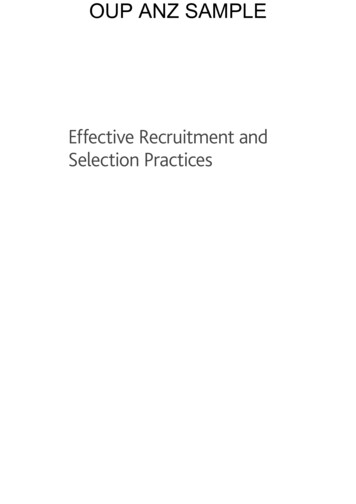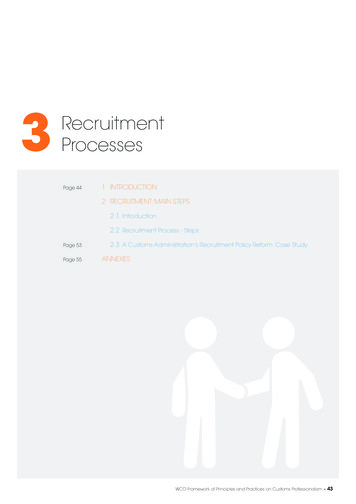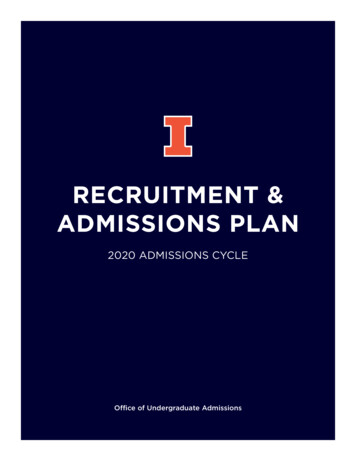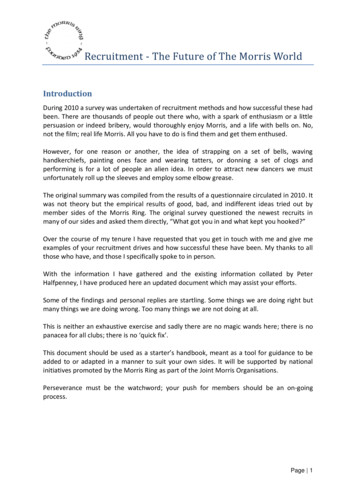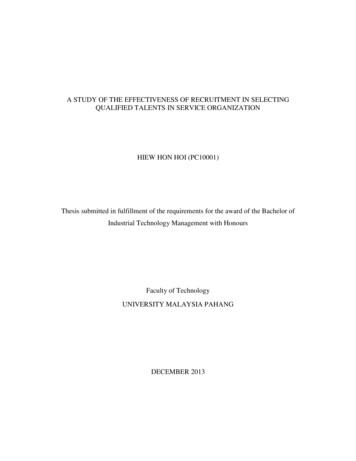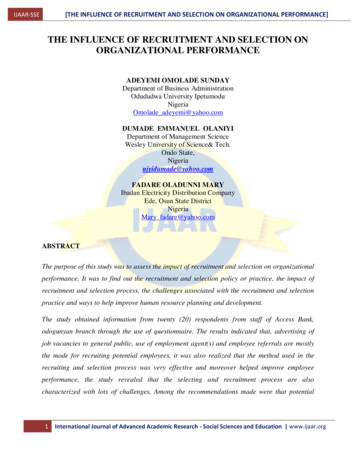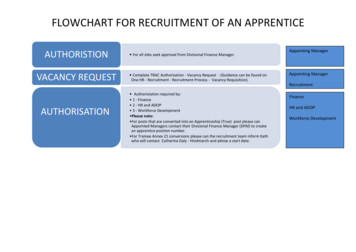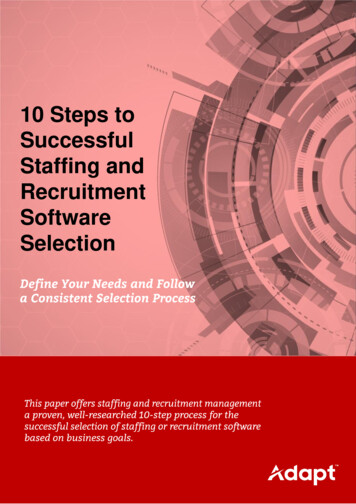
Transcription
The Impact of E-Recruitment and Artificial Intelligence (AI) Tools on HREffectiveness: The Case of High SchoolsLuigi Pio Leonardo Cavaliere, Keshav Nath, Worakamol Wisetsri, Klinge Orlando VillalbaCondori, Dennis Arias-Chavez, Roy Setiawan, Kartikey Koti, and R. ReginAuthorsLuigi Pio Leonardo Cavaliere, Department of Economics, University of Foggia, Via RomoloCaggese, 1, 71121 Foggia FG, Italy. luigi.cavalie@gmail.comKeshav Nath, alUniversityJaipur,India.Worakamol Wisetsri, Department of Manufacturing and Service Industry, Management, Facultyof Business and Industrial Management, King Mongkut's University of Technology NorthBangkok, Bangkok, Thailand. drkapook@gmail.comKlinge Orlando atólicadeSantaMaría,Perú.Dennis Arias-Chavez, Universidad Continental, Arequipa, Perú. darias@continental.edu.peRoy Setiawan, Universitas Kristen Petra, Universitas Airlangga, Indonesia. roy@petra.ac.idKartikey Koti, Acharya Bangalore B-School, Bangalore University, Bangalore, India.R. Regin, Department of Information Technology, Adhiyamaan College of Engineering, TamilNadu, India. regin12006@yahoo.co.inAbstractThe HRM encompasses a broad variety of topics, including preparation, recruiting, workforcerelations and organisational growth. The people in any organisation are a wealth ofinformation and experience. Acquisition of certain workers by recruiting thus plays a majorrole today. The implementation method for e-recruitment practices is the reason behind thesuccess of organisational performance. The recruiting method used to be longer and entaileda great deal of paperwork for recruiters, but it began evolving steadily as online recruitmentbecame more widespread. In recent years, a study has been carried out on integrating thesetwo essential facets of HRM and technology due to technical developments. Studies aretypically carried out about how technologies will render the hiring phase easier and optimised.The research implemented a mixed approach methodology throughout conducting interviewsand questionnaires over a defined number of respondents in High Schools. The survey hadbeen distributed using google forms, and the interviews had been conducted through zoomManuscript: Original published in: Productivity management, 26(1), GITO Verlag, P. 322-343,ISSN 1868-8519, 2021322
meeting due to the COVID-19 Pandemic. The results proved a direct relationship between theimplementation of e-recruitment in School and employee performance.Keywords: E-Recruitment; Time Efficiency; Cost Performance; High Schools; ArtificialIntelligence.IntroductionThe traditional methods to do business are being questioned in today's globalised environment.There are no longer only small businesses as rivals, but businesses must continuously compete,as emerging technologies limit the globe. This ensures that the introduction of these emerginginnovations is crucial for a company to remain up-to-date and retain a competitive edge.Artificial intelligence is one of the most novel fields and has been researched since World War IIin architecture and research. In 1956, the term artificial intelligence was tested.Problem Statement & Research QuestionsCurrently, recruiting is mostly performed by human recruiters who sit and search for theirspecific applicants through CVs, online profiles, and other outlets. Recruiters perform all initialcontacts, provide rejected staff with input, and carry out applicant interviews. Since people haveminimal qualifications, it's not easy to keep up with all the activities involved and typically takestime for each recruiter. The reality is that individual constraints such as prejudices, pre-concept,and time limits will impede the recruiting method's efficacy. The issue is that it is important toaccomplish this. This is a concern since a company will sacrifice both the most desirable workapplicants and the monetary value. Methods for studying technology-based recruiting have beendescribed as inadequate and lie behind the existing practice. More in-depth scientific studies canalso be undertaken in the future to allow for more innovation and clearer access to emergingdevelopments than before. The consequences for the recruiters of emerging technology are alsounknown, as these new and effective technologies create obstacles or openings for the recruiter'sjob. However, the research questions will be addressed as follows: RQ1: How are new technology-based solutions utilised in recruitment processes?RQ2: What kind of opportunities and risks do new technology solutions generate inrecruitment processes?RQ3: What are the prospects of technology-based recruiting?Literature ReviewBackground Overview about E-recruitment, Artificial Intelligence and HR EffectivenessAhmed, E. R., et.al., [1] referred to e-recruiting as cyber-recruiting or e-recruiting. This approachis one of the latest in human resources that determine the qualified and potential candidates.Manuscript: Original published in: Productivity management, 26(1), GITO Verlag, P. 322-343,ISSN 1868-8519, 2021323
Online recruitment has substituted the most internal and external recruitment approach. From alegal point of view, recruitment is defined as the total number of persons recruited by a companyat a particular place or at varying times controlled by local or national rules and laws foremployment. Thus, legal constraints on the recruitment procedure must guarantee collateral andprotection for the employee and the company and handle the greatest interest of both sides.According to Huang, Ahmed, E. R., et.al., [2] e-recruitment is when an organisation uses theinternet, specifically online websites, for employers to post a vacancy about a specific positionand where people looking for employment can post their resume where it matches. E-recruitmentwebsites provide employment details to people seeking a job.Ahmed, E. R., et. al., [3] claims that e-recruitment is not just about sending emails to candidates,inviting them to interviews, or either accepting or rejecting them. However, e-recruitment isreferred to as an approach to apply and execute plans, tactics, and strategies in organisations andinstitutions to assist and use online channels. In the recruitment area, this web-based segmentsthe market trying to locate the potential candidates and then gathering the essential informationthat is important and required for the selection development. Ahmed, E. R., et., al., [4] statedthat e-recruitment is an online tool used to determine, recognise, and attract possible employeesvia advertising for that vacant job using the organisations' websites or job portals. Also, onlinerecruitment can be viewed and considered as an umbrella casing HRM and the whole recruitmentprocess specifically. This web-based process can be used in two forms: first, the company's website for employment, other advertising job portals for posting a job.Artificial IntelligenceTechnology, such as artificial intelligence, is considered, nowadays, to be the crucial factor fororganisations to endure, exist, adapt, and alter in an evolving and shifting atmosphere. Whatmakes artificial intelligence effective and powerful than any other technology is that it has theability and capacity to learn, understand, and make decisions. Despite that, in HRM, there is yetan absence of the whole general use of artificial intelligence and its tools in some organisations.Each day, a new and modern technology emerges into the market, such as AR or augmentedreality, AI or artificial intelligence, 3D printing, algorithms, robots, and many others. All thesetechnologies are being created and made to improve, assist, and facilitate individuals' personaland business lives.Previous Studies about Artificial IntelligenceJohn McCarthy is the man who created and came up with artificial intelligence. He started hisresearch and studies on this matter in 1955 and supposed that every characteristic of AI can becopied and substituted by a machine. Artificial intelligence is known to be shortened as AI. 1AI is1Artificial IntelligenceManuscript: Original published in: Productivity management, 26(1), GITO Verlag, P. 322-343,ISSN 1868-8519, 2021324
work operations where knowledge is needed if applied by a human. Alabdullah, et al., [5]defined artificial intelligence that it is "investigating intelligent problem-solving behaviour andcreating intelligent computer systems.". The expression AI was recommended and proposed in aconference, for the first time, in the United States of America in the year 1956. It is used toanalyse a particular case or circumstance and maximise by selecting the optimum resolution bymimicking human rationality and artificial intelligence. AI is currently used in translation,gaming, robots, speech, and image (face) recognition, printed documents, and texts, etc.The "A" in Artificial Intelligence refers to Artificial and is accepted worldwide. However, manystudies aim to define the "I" since it is the most difficult to identify. As stated in the OxfordDictionary, artificial is something "made or produced by human beings rather than occurringnaturally, especially as a copy of something natural." The difficult, complicated, and sensitivepart is in identifying intelligence. Various researchers would determine the word AI as thedevelopment and establishment of robots, machines, computers, or software that dwell andimitate human being's behaviours and intelligence. AI can be used in many fields as languageinterpretation/translation, machine understanding, awareness, and perception, problem-solving,robotics, and finally, gaming.Another definition for artificial intelligence, as stated by D Datta, et.al., [6] is "machines thatrespond to stimulation consistent with traditional responses from humans, given the humancapacity for contemplation, judgment and intention." Another term used for artificial intelligenceis machine intelligence or machine learning. AI is instantaneously reforming and changing aconsiderable number of organisations at a rapid pace. AI is an "intelligent agent" that senses,observes, and comprehends its surrounding and make a decision that optimises reaching its goalseffectively, efficiently, and successfully.Therefore, AI is implemented when a machine imitates analytical tasks and operations suchlikeproblem solving and learning. AI is capable of perceiving and grasping human speech,independently running a vehicle, etc. AI can be divided into three kinds: analytical, humaninspired, in addition to humanised AI [7]. The analytical type is characterised by usingintellectual knowledge based on previous experience and events to make later choices anddecisions. Artificial intelligence based on human-inspiration is made up of mental andintellectual knowledge and emotional quotient or, in other word EI; these are the factors andaspects human beings rely on to make a particular decision. Finally, humanised artificialintelligence represents all kinds of features: mental, emotional, and cultural knowledge,makingne capable of interacting with others [8].AI can be categorised into two parts; weak and strong artificial intelligence. The weak artificialintelligence, or in other words limited artificial intelligence, concentrates on restricted tasks suchas a self-driving vehicle [9]. The intense artificial intelligence, or in other terms, comprehensiveartificial intelligence, is a system with alertness, responsiveness, and consciousness, and thisManuscript: Original published in: Productivity management, 26(1), GITO Verlag, P. 322-343,ISSN 1868-8519, 2021325
system or machine has knowledge, understanding, intelligence, and perception in many fields[10]. An additional elaboration regarding these two parts is that the weak AI refers to computersor machines as just a mean or a device for studying rational and intellectual processes, meaningthe machine only imitates and mimicked knowledge and intelligence [11]. Strong AI states thatthe machine's approaches and methods are intelligent, reasonable, logical, and rational. They cancomprehend an exact and precise software and therefore enhance and improve their operationsbased on past experiences. This incorporates spontaneous and intuitive connecting with othercomputers and machines, which results in an impressive scaling outcome [12].Levels of Artificial IntelligenceArtificial intelligence is divided into three layers; the necessary support, the platform framework,and the area of technology [13]. The first layer, which is the first support layer, is composed ofthree main fundamentals: vast data, figuring power, and technology layer. Broad data offerscontrol for artificial intelligence's growth and development through the new algorithm templateswith enhanced machine learning competencies [14]. For example, deep learning ensures that alltasks as managed, unmanaged, and concentrated learning are carried out correctly. The secondlayer, the platform framework, is online websites, like Amazon, Google, Facebook, etc., used bycompanies and especially universities [15]. Some of them have introduced and implementedtheir platform, such as the University of California, University of Montreal. Finally, thetechnology layer that is being used in different sectors and areas [16]. It comprises computervision, normal speech processing as Siri, face and image recognition, e-payments, smartspeakers, translation programs and autocorrect, and many more, shown in figure 1.Basic ameworkLayerTechnologyLayerFigure 1. Levels of Artificial IntelligenceThe first stage ANI is mostly the basic one in AI. It is limited to only a single functional area.The second stage is AGI, which is the advanced stage [17]. It incorporates reasoning, problem-Manuscript: Original published in: Productivity management, 26(1), GITO Verlag, P. 322-343,ISSN 1868-8519, 2021326
solving, abstract intelligent, which is to human beings [18]. The last stage is ASI which exceedshuman intelligence in all areas and is considered the highest form, shown in figure 2.Stage 1:ANIStage 2: AGIStage 3: ASIFigure 2. The basic stages of AIFor artificial intelligence to be understandable, it is best to understand and comprehendintellectual digitalisation levels [19]. The first level is assisted intelligence created to improveand enhance what individuals and organisations are doing by automating repetitive andmonotonous tasks such as the GPS in vehicles nowadays, which is made to provide directionsand road situations [20]. The second is augmented intelligence; that is permitting individuals andmachines to take, together, a particular decision [21]. The third and the last is autonomousintelligence which is the supreme and the best form [22]. When machines and computers actsolely, as an example of that is self-driving or autonomous vehicles, shown in figure 3.AssistedIntelligenceLevels ure 3. The intellectual digitalisation levelsManuscript: Original published in: Productivity management, 26(1), GITO Verlag, P. 322-343,ISSN 1868-8519, 2021327
Artificial Intelligence ToolsIn 1993, Intel microprocessor added to a massive number of applications graphics and musiccapacities [23]. This was the beginning of a new generation that involves robots, intelligentpersonal assistants, autonomous vehicles, and many other capabilities and competencies that areexclusive and can only be done by human beings [24]. Individuals who are technology savvyclaimed that, in no more than twenty-five years, computers are being used in complex andcomplicated algorithms such as comprehending and speaking of natural languages when it wasonly used for coding and handling the digits of 0 and 1 [25].The Impact of E-recruitment on Effectiveness of HRThe prompt, quick, and rapid expansion in innovation and technology has led to many changes inevery department in organisations [26]. Managers are accepting and using the latest andadvanced ways and methods for recruiting and selecting candidates. Recruitment is a corecomponent of human resources. Human resources activities, and especially recruitment, are notcompleted in the modern world unless using the internet [27]. Nowadays, companies andorganisations are using their websites or job portals to post a vacant position and attract the rightperson. E-recruitment supports managers in reducing stress, time wasted, decreasing the timeneeded for the recruitment cycle, money spent and saving their resources [28]. This onlinerecruitment has transformed the staff's life and the organisation by increasing productivity andwealth [29].Also, a larger pool of talented and experienced candidates is being attracted through erecruitment [30]. The risk concerning the candidate's background, education, experiences, andqualification of the significant field has been reduced using e-recruitment. Besides, a load ofwork and tasks to be done by human resources managers, recruiters, and recruitment agencies isbeing limited, leading to increased job satisfaction. It has become quite simple to shortlist theneeded candidate. The benefit of online recruitment is that a databank will save, keep, andreserve all the applicants' information. Finally, companies fail by only using e-recruitment; italso needs to have appropriate, adequate, and decent planning and implementation.Human resources always are the lead of using the latest innovation and technologies incompanies. Payroll warning is one of the new procedures that has been automated. For instance,many companies are keeping records of their employees through computers. Administrativeefficiency has been increasing after using human resource information systems or, in otherwords, HRIS. As time is passing, HR professionals are looking more into the possibilities ofusing the internet and more latest technologies in the human resources field. Nowadays, e-HRincorporate enterprise resource planning (or ERP), voice recognition systems (or VRS),interactive voice response (or IVR), and many others that are artificial intelligence tools.Electronic, human resources are defined as practising human resources activities using electronicplatforms. Managers, through e-HR, will be able to have access to relevant and significant data,Manuscript: Original published in: Productivity management, 26(1), GITO Verlag, P. 322-343,ISSN 1868-8519, 2021328
carry out an analysis, decide, and communicate with other individuals with the advice of HRprofessionals unless they decide otherwise. As for the employees, they can monitor, regulate,and update their information. Regarding the HR operations, e-HR will reduce paper-based tasks,minimise the unwanted staff, and enhance accuracy and capabilities for making more effectivedecisions.Finally, the time and effort spent on administrative tasks shall be substituted by managerial,strategic, competitiveness issues and focusing more on relationship building, knowledgemediator, and human capital steward. E-HR may influence each area of human resourcesmanagement that are essential. Starting with HR planning, e-HR gives managers and employeesthe chance to access data to update their personal information. This will lead to better accuracyand higher quality of data. Regarding acquiring resources or recruitment and selection, e-HRbrings significant advantages about the quality of response, time, money, sorting applicants, andapplicants’ pool. On the other hand, there is always a risk of excess of resumes, a bad reputationfor certain websites and databanks, without forgetting its uncertain effectiveness for senior andmanagerial positions.Concerning the evaluation process, e-HR permits the performance appraisal to be done throughthe company's internet interface. This will reduce paperwork, cost, and time. It will allowmanagers and employees to present their performance information directly to the humanresources department electronically. This will also supply managers with the criteria needed tobe able to accomplish an effective PA. The positive effects of e-HR regarding communicationare significant. It changed and upgraded corporate communication enabling the enhancement ofupward communication within an organisation. Training and development of employees throughthe internet is undoubtedly one of the most profitable aspects of using e-HR. E-learning can bedone through a wide range of resources such as links to many websites, streaming video, etc. It istailor-made learning that is being made to fit the learner specifically. The switch from traditionalhuman resources to modern or e-HR affects HRM in many ways. Other than its effect on costand time, e-HR is considered an opportunity and a threat since the implementation of ElectronicHuman resources tend to minimise cost and labour, but at the same time enhances performance.The contribution of employees and human resources managers is increasing gradually to e-HR.The Impact of Artificial Intelligence on HRSince two-hundred years ago, alerts and warnings have been raised that machines and moderntechnologies will replace a considerable number of jobs, mainly middle-class jobs. The mainissue is not only about having jobs disappearing, but it is also about the new posts that will not becreated in return due to machines and automation. Previously, new organisations employed moreindividuals than those they fire, which is not considered this case nowadays. The rapid growth intechnology can bring economic confusion, breakdown, and turmoil instead of environmentalsince machines and processors are becoming powerful and effective that companies are relyingManuscript: Original published in: Productivity management, 26(1), GITO Verlag, P. 322-343,ISSN 1868-8519, 2021329
on them to do the job instead of relying on the workers and employees. The acceleration intechnology will affect and change jobs and what they pay.Artificial intelligence may be utilised in the extraction of data, scanning, and classifying resumeautomatically. The human resources department used to manually assess the job applications,whereas nowadays, and with AI, recruiters find it easier to rank applications received through thealgorithm, which is a form of artificial intelligence. An interesting aspect of artificial intelligenceis collecting personality traits about the candidates that are beneficial when accomplishing andcompleting job positions. Though these traits can be pointed out during the interview,preliminary figures and information could be attained through searching the web throughperforming a linguistic evaluation to the candidates' blog post, social media, LinkedIn, etc. thereis the possibility to collect and assemble information about the candidates' feelings, affections,and personality traits. Also, an application was made specifically for video interviews calledHireVue.By using this application, artificial intelligence can examine, study, analyse, and understandcandidates' facial expressions, tonality, and body language. Then, it compares thesecharacteristics with the talented employees and therefore proposes the best fit candidate torecruiters. Recruitment and selection are some of the major functions of HRM that have beenaffected by technological development. Recently, the use of artificial intelligence in therecruitment process is frequently increasing. Various scholars examined and suggested modelsthat have integrated AI with recruitment operations.One of the AI methods used in recruitment is called a knowledge-based browser. It is created forfinding a suitable candidate based on a certain semantic annotation. In return, recruiters muststate a keyword or, in other terms, "reasoner" that points out the qualifications that the vacant jobrequires. Hence, this knowledge-based engine will extract though the system the candidates thatmatch the position. This will save time and money as well as reducing human errors, favouritism,and biases. Another method of artificial intelligence that is frequently used in recruitment in datamining. D Datta, et. al., [6] refers to data mining as extracting effective yet unknown,understandable, and actionable data from huge records through an automatic or semi-automaticdevice to take important and essential business-wise decisions. Data mining is an effectivemethod for extracting data that might be beneficial and used for resume attainment in thescreening process.Also, intelligent text processing used for opinion analysis. This technique extracts sentimentsinside a random text and arranges them under two categories; positive and negative sentiments.With the help of this technique, recruiters will assess the candidates based on their opinions andthoughts. An additional technique of artificial intelligence is called Artificial Neural Network orANN. This technique is used to examine the learning capabilities of each applicant and assessManuscript: Original published in: Productivity management, 26(1), GITO Verlag, P. 322-343,ISSN 1868-8519, 2021330
their managerial capacities. Finally, ANN may be used to predict employees' forthcomingperformance.Furthermore, "Chatbots" are artificial intelligence software used to communicate and interactwith applicants and are an example of intuitive AI. After the applicant is done applying for theposition, the chatbot will start interview screening, multiple evaluation tests and responding tothe candidates' questions. Also, studies have shown that most of the applicants will bedisappointed if the recruiters did not provide them with feedback; thus, the chatbot providesprompt and immediate feedback and updates during the recruitment and selection process, whichabolishes the gap between the recruiters and candidates.An example of chatbots is Mya and Olivia. Mya is an automated recruitment associate thatutilises intellectual neural language to offer candidates immediate feedback; it computerises 75%of the recruitment process. It has become crystal clear that artificial intelligence helps inoptimising the recruitment process. Artificial intelligence tools minimise monotonous tasks thatare costly and time-consuming such as sourcing and screening candidates. These tools will resultin more transparency to the recruitment process, reduce human biases, discrimination, andimprove organisations' brand name and images. Employees nowadays, with all the innovation,expect to have more personalised interactive and technological surroundings. Approximately 8%of companies have already started using and implementing artificial intelligence, and 21% areexamining and assessing the use of technology in the coming years.The primary cause for organisations to use artificial intelligence is the responsiveness offered bychatbots. Artificial intelligence helps organisations retain their employees, monitor development,and progress, and make better decisions based on the system's facts and data. The exactness ofartificial intelligence is likely to be 95%. Even though artificial intelligence offers many benefitsto the company; however, it cannot consider the cultural traits, non-technical aspects, and otherintangible behaviours that a candidate could bring to the company. Also, since artificialintelligence is replacing many jobs used by humans, it is feared that a huge number of jobs willdisappear and the unemployment rate will gradually increase. It must be noted that machinescannot be left alone to do the work because a single mistake can cost a lot, considering the speedthat a computer works and deliver results.One of the biggest challenges regarding implementing artificial intelligence is personalinformation privacy and the unaware discrimination during the recruitment process. Althoughartificial intelligence is growing and becoming powerful, humans can never be replaced bymachines or computers because of a simple reason: "Emotional Intelligence" or EI 2. Machinescan never have the complexity of human brains. In addition to EI, machines lack reasoning thatis present in human beings. Regardless of how intelligence these computers and machines are,The capacity to be aware of, control, and express one’s emotions, and to handle interpersonal relationshipsjudiciously and empathetically.2Manuscript: Original published in: Productivity management, 26(1), GITO Verlag, P. 322-343,ISSN 1868-8519, 2021331
they will never be able to cope with and react to human emotions, reactions, and sentiments in adependable way.Research DesignThis part of the research will address the research philosophy, hypotheses, research approach,research strategy, research choice and time horizon.HypothesesThe following hypotheses will be tested throughout the research: H1: Employees skills is affected by e-recruitment in SCHOOLH2: Advanced technology affects e-recruitment in SCHOOLH3: Time management affects e-recruitment in SCHOOLSources of DataBoth primary and secondary source of data was used in conducting the research.Primary DataSeveral methods of data processing are accessible, as primary data is obtained. The researchercalled the Human Resources Department in High Schools to gather accurate and relevant details.The way the primary data was gathered is through implementing the questionnaires andinterviews.QuestionnairesThe questionnaire was structured to define and assess the effectiveness of School recruitmentand selection activities using Online Platforms. A collection of questionnaires of accessible andclosed questions is planned.InterviewsThe interviews were conducted with four employees from the human resources department.Questions asked were semi-structured. One interview was done with a senior talent acquisitionmanager, one with junior talent acquisition, one with a recruiter, and the last one with a regionalHR specialist; this was to ensure a variety of answers and different point of views.Manuscript: Original published in: Productivity management, 26(1), GITO Verlag, P
inviting them to interviews, or either accepting or rejecting them. However, erecruitment is - referred to as an approach to apply and execute plans, tactics, and strategies in organisations and institutions to assist and use online channels. In the recruitment area, this web-based segments


